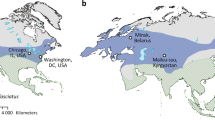Abstract
In this paper we discuss the potential usefulness of determining the phylogeographic and phylogenetic patterns of a vector for understanding the spread of pathogens or insecticide resistance. We do so using the example of Pulex simulans in Peru. Six populations from six different localities were investigated. Mitochondrial DNA sequences were obtained and branching patterns were inferred using phylogenetic reconstruction methods and nested clade analyses. Ten different haplotypes were discovered. Phylogenetic analysis revealed P. simulans in Peru as a monophyletic group, containing clades that were generally not geographically correlated. The data suggest that P. simulans is not a single genetic entity but rather that this species shows a high degree of intraspecific variation. Restricted gene flow with long distance dispersal coupled with range expansion and long distance colonization are likely to have contributed to the observed patterns of variation.



Similar content being viewed by others
References
Acha P, Szyfres B (1994) Zoonoses and communicable diseases common to man and animals. PAHO, Washington
Campos J, Andrade CF (2002) Insecticide resistance in Simulium populations (Diptera, Simuliidae). Cad Saude Publ 18:661–671
Didier R, La Scola B (2001) A flea associated Rickettsia pathogen of humans. Emerg Infect Dis 7:23–29
Dittmar K (2001) Untersuchungen zum Vorkommen von Ektoparasiten bei domestizierten und wildlebenden Meerschweinchen (Cavia spp.) sowie an präinkaischen Meerschweinchenmumien in Peru, Südamerika. Doctoral dissertation, University of Leipzig, Leipzig
Felsenstein J (1995) Confidence limits on phylogenies: an approach using the bootstrap. Evolution 39:783–791
Huelsenbeck JP, RonquistF, Nielsen R, Bollback JP (2001) Bayesian inference of phylogeny and its impact on evolutionary biology. Science 294:2310–2314
Johnson KP, Seger J (2001) Elevated rates of nonsynonymous substitution in Island birds. Mol Biol Evol 18:874–881
Kuhner MK, Yamato J, Felsenstein J (1995) Estimating effective population size and neutral mutation rate from sequence data using Metropolis-Hastings sampling. Genetics 140:1421–1430
Kumar S, Tamura K, Jakobsen IB, Nei M (2001) MEGA2: molecular evolutionary genetics analysis software. Bioinformatics 17:1244–1245
Maekawa K, Kitade O, Matsumoto T (1999) Molecular phylogeny of the orthopteroid insects based on the mitochondrial cytochrome oxidase II gene. Zool Sci 16:175–184
Mikevich MF, Farris SJ (1981) The implications of congruence in Menidia. Syst Zool 30:351–370
Posada D, Crandall KA (1998) MODELTEST: testing the model of DNA substitution. Bioinformatics 14:817–818
Posada D, Crandall KA, Templeton AR (2000) GEODIS: a program for the cladistic nested analysis of the geographical distribution of genetic haplotypes. Mol Ecol 9:487–488
Sorenson MD (1999) TreeRot, version 2. Boston University, Boston
Swofford DL (1998) PAUP* Phylogenetic analysis using parsimony (*and other methods), version 4.0. Sinauer, Sunderland, Mass.
Tajima F (1989) Statistical method for testing the neutral mutation hypothesis by DNA polymorphism. Genetics 123:585–596
Templeton AR (1998) Nested clade analysis of phylogeographic data: testing hypotheses about gene flow and population history. Mol Ecol 7:381–397
Templeton AR, Sing CF (1993) A cladistic analysis of phenotypic associations with haplotypes inferred from restriction endonuclease mapping. IV. Nested analysis with cladogram uncertainty and recombination. Genetics 134:659–699
Templeton AR, Routman E, Phillips CA (1995) Separating population structure from population history: a cladistic analysis of geographical distribution of mitochondrial DNA haplotypes in the tiger salamander Ambystoma tigrinum. Genetics 140:767–782
Zhang J, Rosenberg HF, Nei M (1998) Positive Darwinian selection after gene duplication in primate ribonuclease genes. Proc Natl Acad Sci U S A 95:7308–7313
Ziam M, Guillet P (2002) Alternative insecticides: an urgent need. Trends Parasitol 10:161–163
Acknowledgements
We thank the Karl-Enigk-Foundation, Germany, and the NSF grant no. DEB 9983195 for support and Manuel Gonzales for the help obtaining the Salas specimen.
Author information
Authors and Affiliations
Corresponding author
Rights and permissions
About this article
Cite this article
de la Cruz, K.D., Whiting, M.F. Genetic and phylogeographic structure of populations of Pulex simulans (Siphonaptera) in Peru inferred from two genes (CytB and CoII). Parasitol Res 91, 55–59 (2003). https://doi.org/10.1007/s00436-003-0879-5
Received:
Accepted:
Published:
Issue Date:
DOI: https://doi.org/10.1007/s00436-003-0879-5




